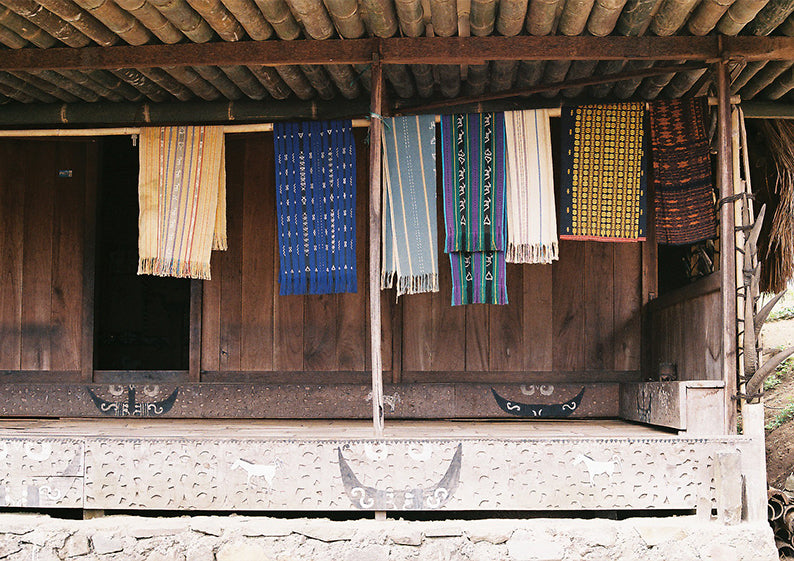


Jessica Adams is a Product Developer at TOAST and a weaver. Here she talks of the Ikat weaving in Flores, Indonesia, following her recent trip.
If you fly from Bali to the island of Flores you need a window seat. It is said that the amount of islands in Indonesia numbers over 17,000 and from 30,000 feet they spread as far as the eye can see.
Covered in a deep verdant green and set in the azure blue sea that joins the Indian and Pacific Oceans, Flores is lush and mountainous and some 354 km in length. Starting in the East we traveled at a leisurely pace along the twisting roads, through jungles and terraced rice fields, passing volcanic mountains and small villages hugging the coastline.
As well as its stunning beauty, Flores is renowned for its intricate Ikat weaves, particularly from the towns of Maumere and Ende both of which I visited during my trip at the start of the New Year. After only a short time on the island I was struck by the still prominent use of fine Ikats in day-to-day life. Local women, young and old, can be seen on the backs of motorbikes or shopping in the local markets, wrapped in the most beautiful weaves. Here Ikats are still a proud statement of Flores culture, despite the growing influx of mass produced textiles.
The fabrics are painstakingly hand spun, dyed and woven in the traditional way. One such place where they are still made is the village of Sikka. The town is set against the back drop of swaying palms and volcanic black sand beaches and boasts a beautiful 18th century church on the steps of which women meet and chatter at the end of the day.
The villagers grow much of the cotton used in Sikka, which is softened and cleaned with hand crafted wooden tools. It is then spun by hand on small wheels into a fine yarn. The yarn is wound onto a frame to create the warp. Here they warp wind in pairs to speed up the process, the ball of yarn held in half a coconut shell for easy release.
The warp yarns are then tied with lontar (strips of palm leaf) to create the pattern. This works in the same way as a tie-dye, the section of yarn beneath the tie will not take the colour. After dyeing, the warp can be tied again and overdyed several times to create a wide range of colours or tones. Once the dyeing process is complete the warp yarns need to threaded onto the loom, each yarn in precisely the correct position to recreate the desired pattern. Inevitably the yarns will not align exactly and this creates the characteristic blurred look of an ikat cloth.
Natural dyes are the primary source of colour in Sikka. Indigo for the blues, Mango leaves for pale green, mangrove bark for black, turmeric for yellow and Morinda for red. The yarns may need to be dyed several times over many months to achieve the darker colours. Lime from the sea coral is used as a fixing mordant.
The patterns and symbols used in the designs are deeply connected to the way of life on Flores. For example, the weavers of Sikka use many stars in their designs to symbolize the night sky under which the fishermen sit for many lonely hours.
We visited another weaving village at the base of Mt. Inerie, Bena, home to the Ngada people. As the jungle cleared the view was spectacular, high mountain ranges, a volcanic peak and the blue sea in the distance. The houses are built in a ring around the central stone alter, which is used for rituals and sacrifice. There are many bleached cow skulls and horns tied to the front of the houses, which are saved from these sacrifices. The houses have tall peaked roofs topped with figures of either men or women and symbolic decorations carved into the wood.
Each house has a porch on which the weaving takes place. Here black is used as the base colour in their weaves. To the Ngada people black symbolizes genuineness, originality and pureness. The horse motif can be seen in many of their textiles, symbolizing wealth. I managed to communicate that I too was a weaver, through hand gestures and photos, and was invited to have a go on one of their back strap looms, quite different to my loom at home. My efforts caused much laughter amongst us all a universal language.
Young children sat beside their mothers and grandmothers, watching as the cloth materialized on the looms, learning the craft to carry forward into the next generation.
Words and images by Jessica Adams.
Shop TOAST ikat pieces.




Add a comment